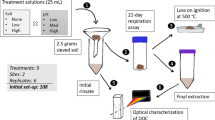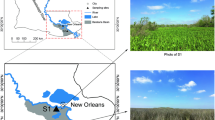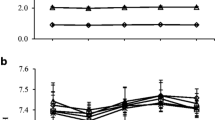Abstract
Salt-affected soils are widespread, particularly in arid climates, but information on nutrient dynamics and carbon dioxide (CO2) efflux from salt-affected soils is scarce. Four laboratory incubation experiments were conducted with three soils. To determine the influence of calcium carbonate (CaCO3) on respiration in saline and non-saline soils, a loamy sand (6.3% clay) was left unamended or amended with NaCl to obtain an electrical conductivity (EC) of 1.0 dS m−1 in a 1:5 soil/water extract. Powdered CaCO3 at rates of 0%, 0.5%, 1.0%, 2.5%, 5.0% and 10.0% (w/w) and 0.25-2 mm mature wheat residue at 0% and 2% (w/w) were then added. Cumulative CO2-C emission from the salt amended and unamended soils was not affected by CaCO3 addition. To investigate the effect of EC on microbial activity, soil respiration was measured after amending a sandy loam (18.8% clay) and a silt loam (22.5% clay) with varying amount of NaCl to obtain an EC1:5 of 1.0–8.0 dS m−1 and 2.5 g glucose C kg−1 soil. Soil respiration was reduced by more than 50% at EC1:5 ≥ 5.0 dS m−1. In a further experiment, salinity up to an EC1:5 of 5.0 dS m−1 was developed in the silt loam with NaCl or CaCl2. No differences in respiration at a given EC were obtained between the two salts, indicating that Na and Ca did not differ in toxicity to microbial activity. The effect of different addition rates (0.25–2.0%) of mature wheat residue on the response of respiration to salinity was investigated by adding NaCl to the silt loam to obtain an EC1:5 of 2.0 and 4.0 dS m−1. The clearest difference between salinity levels was with 2% residue rate. At a given salinity level, the modelled decomposition constant ‘k’ increased with increasing residue addition rate up to 1% and then remained constant. Particulate organic carbon left after decomposition from the added wheat residues was negatively correlated with cumulative respiration but positively correlated with EC. Inorganic N (NH +4 -N and NO −3 -N) and resin P significantly decreased with increasing salinity. Resin P was significantly decreased by addition of CaCl2 and CaCO3.




Similar content being viewed by others
References
Agarwal AS, Singh BR, Kanehiro Y (1971) Ionic effect of salts on mineral nitrogen release in an allophanic soil. Soil Sci Soc Am J 35:454–457
Azam F, Ifzal M (2006) Microbial populations immobilizing NH4+-N and NO −3 -N differ in their sensitivity to sodium chloride salinity in soil. Soil Biol Biochem 38:2491–2494
Baldock JA (2002) Interactions between organic materials and microorganisms with minerals in the stabilization of soil structure. In: Huang PM, Bollag JM, Senesi N (eds) Interactions between soil particles and microorganisms: impact on the terrestrial ecosystem. Wiley, New York, pp 85–131
Baldock J, Masiello C, Gelinas Y, Hedges J (2004) Cycling and composition of organic matter in terrestrial and marine ecosystems. Mar Chem 92:39–64
Bertrand I, Delfosse O, Mary B (2007) Carbon and nitrogen mineralization in acidic, limed and calcareous agricultural soils: apparent and actual effects. Soil Biol Biochem 39:276–288
Blake GR (1965) Bulk density. In: Black CA, Evans DD, Ensminger LE, White JL, Clark FE (eds) Methods of soil analysis. Part 1. Physical and mineralogical properties. American Society of Agronomy, Madison, pp 374–390
Chen Y, Barak P (1982) Iron nutrition of plants in calcareous soils. Adv Agron 35:217–240
Henrikson A, Selmer-Olsen AR (1970) Automatic method for determining nitrate and nitrite in water and soil extracts. Analyst 95:514
Hungate BA, Dijkstra P, Johnson DW, Hinkle CR, Drake BG (1999) Elevated CO2 increases nitrogen fixation and decreases soil nitrogen mineralization in Florida scrub oak. Glob Chang Biol 5:781–789
Irshad M, Honna T, Yamamoto S, Eneji AE, Yamasaki N (2005) Nitrogen mineralization under saline conditions. Commun Soil Sci Plan 36:1681–1689
Isbell R (2002) The Australian soil classification. CSIRO, Australia, pp 1–144
Janik LJ, Merry RH, Skjemstad JO (1998) Can mid infrared diffuse reflectance analysis replace soil extractions? Aust J Exp Agric 38:681–696
Janik LJ, Skjemstad JO, Shepherd KD, Spouncer LR (2007) The prediction of soil carbon fractions using mid-infrared-partial least square analysis. Aust J Soil Res 45:73–81
Kelly J, Rengasamy P (2006) Diagnosis and management of soil constraints: transient salinity, sodicity and alkalinity. The University of Adelaide and Grains Research and Development Corporation, Australia, pp 1–32
Kouno K, Tuchiya Y, Ando T (1995) Measurement of soil microbial biomass phosphorus by an anion exchange membrane method. Soil Biol Biochem 27:1353–1357
Laura RD (1974) Effects of neutral salts on carbon and nitrogen mineralisation of organic matter in soil. Plant Soil 41:113–127
Leininger S, Urich T, Schloter M, Schwark L, Qi J, Nicol G, Prosser J, Schuster S, Schleper C (2006) Archaea predominate among ammonia-oxidizing prokaryotes in soils. Nature 442:806–809
Li X, Li F, Cui Z, Rengel Z (2006) Decomposition of maize straw in saline soil. Biol Fertil Soils 42:366–370
Marriott EE, Wander M (2006) Qualitative and quantitative differences in particulate organic matter fractions in organic and conventional farming systems. Soil Biol Biochem 38:1527–1536
McClung G, Frankenberger W (1987) Nitrogen mineralization rates in saline vs. salt-amended soils. Plant Soil 104:13–21
Mengel K, Kirkby EA, Kosegarten H, Appel T (2001) Principles of plant nutrition. Kluwer Academic, Dordrecht
Metternicht GI, Zinck JA (2003) Remote sensing of soil salinity: potentials and constraints. Remote Sens Environ 85:1–20
Muneer M, Oades JM (1989) The role of Ca-organic interactions in soil aggregate stability. I. Laboratory studies with glucose 14C, CaCO3 and CaSO4. 2 H2O. Aust J Soil Res 27:389–399
Murphy J, Riley JP (1962) A modified single solution method for the determination of phosphate in natural waters. Anal Chim Acta 27:31–36
Nelson PN, Ladd JN, Oades JM (1996) Decomposition of 14C-labelled plant material in a salt-affected soil. Soil Biol Biochem 28:433–441
Oehl F, Oberson A, Sinaj S, Frossard E (2001) Organic phosphorus mineralization studies using isotopic dilution techniques. Soil Sci Soc Am J 65:780–787
Oren A, Steinberger Y (2008) Coping with artifacts induced by CaCO3–CO2–H2O equilibria in substrate utilization profiling of calcareous soils. Soil Biol Biochem 40:2569–2577
Pathak H, Rao DLN (1998) Carbon and nitrogen mineralization from added organic matter in saline and alkali soils. Soil Biol Biochem 30:695–702
Qadir M, Schubert S (2002) Degradation processes and nutrient constraints in sodic soils. Land Degrad Dev 13:275–294
Rayment G, Higginson F (1992) Australian laboratory handbook of soil and water chemical methods. Inkata, Sydney, pp 38–57
Rengasamy P (2006) World salinization with emphasis on Australia. J Exp Bot 57:1017
Rengasamy P, Olsson KA (1991) Sodicity and soil structure. Aust J Soil Res 29:935–952
Rengasamy P, Greene RSB, Ford GW, Mehanni AH (1984) Identification of dispersive behaviour and the management of red-brown earths. Aust J Soil Res 22:413–431
Rietz DN, Haynes RJ (2003) Effects of irrigation-induced salinity and sodicity on soil microbial activity. Soil Biol Biochem 35:845–854
Searle PL (1984) The Berthelot or indophenol reaction and its use in the analytical chemistry of nitrogen: a review. Analyst 109:549–568
Setia R, Sharma K, Marschner P, Singh H (2009) Changes in nitrogen, phosphorus, and potassium in a long-term continuous maize–wheat cropping system in India. Commun Soil Sci Plan 40:3348–3366
Shainberg I, Letey J (1984) Response of soils to sodic and saline conditions. Hilgardia 52:1–57
Skjemstad J, Spouncer L, Cowie B, Swift R (2004) Calibration of the Rothamsted organic carbon turnover model (RothC ver. 26.3), using measurable soil organic carbon pools. Aust J Soil Res 42:79–88
Wichern J, Wichern F, Joergensen R (2006) Impact of salinity on soil microbial communities and the decomposition of maize in acidic soils. Geoderma 137:100–108
Wong VNL, Dalal RC, Greene RSB (2009) Carbon dynamics of sodic and saline soils following gypsum and organic material additions: a laboratory incubation. Appl Soil Ecol 41:29–40
Acknowledgements
The authors would like to acknowledge Mr. Sean Forrester for MIR analyses and predictions, North and Yorke Natural Resources Management Board, Department of Climate Change and The Future Farm Industries CRC for funding, Merv Lewis, John Snodgrass and Paul March for access to their properties and Dr. P. Rengasamy for comments on the manuscript. R. Setia also acknowledges the scholarship from The University of Adelaide.
Author information
Authors and Affiliations
Corresponding author
Rights and permissions
About this article
Cite this article
Setia, R., Marschner, P., Baldock, J. et al. Is CO2 evolution in saline soils affected by an osmotic effect and calcium carbonate?. Biol Fertil Soils 46, 781–792 (2010). https://doi.org/10.1007/s00374-010-0479-3
Received:
Revised:
Accepted:
Published:
Issue Date:
DOI: https://doi.org/10.1007/s00374-010-0479-3




